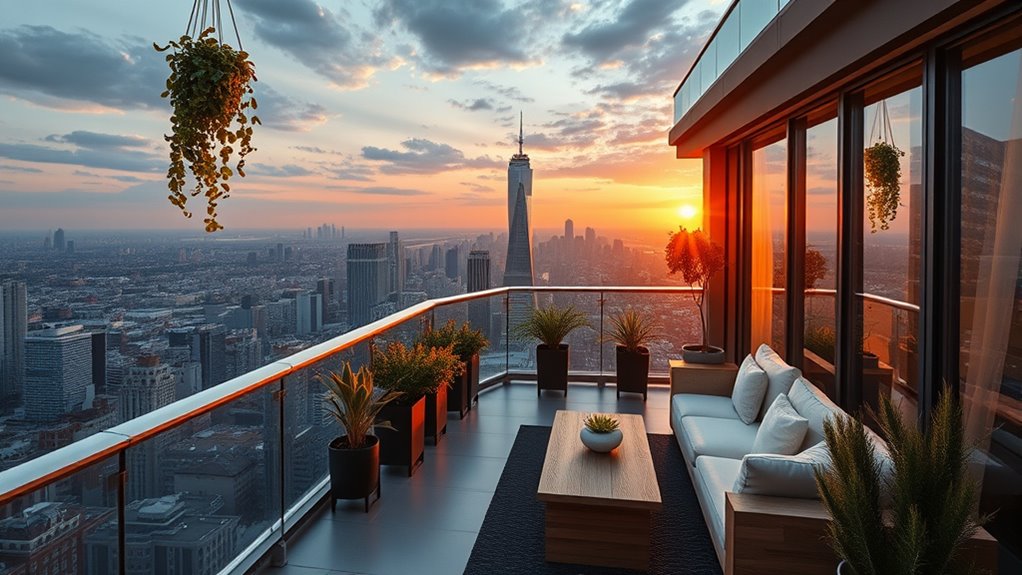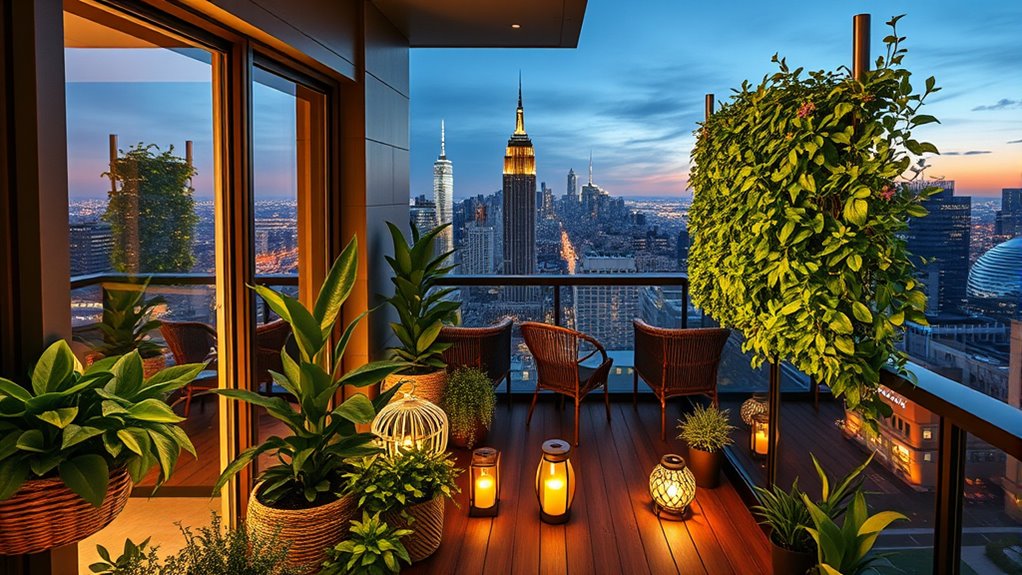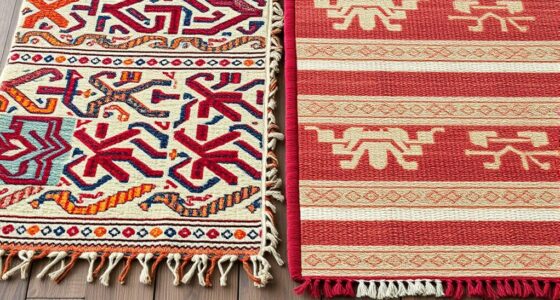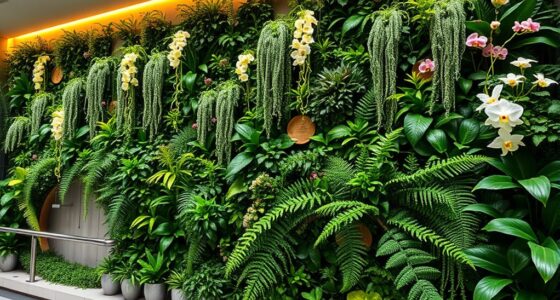Sustainable luxury in urban penthouses means transforming high-rise living with lush green roofs and eco-friendly materials. You can enjoy gardens on your rooftop that help with insulation, reduce energy costs, and create a peaceful oasis amid the city bustle. Using recycled steel, sustainable wood, and low-VOC paints, your home becomes both elegant and eco-conscious. Fascinating ways to combine luxury and sustainability await as you explore how these innovations reshape city living.
Key Takeaways
- Green roofs in penthouses provide natural insulation, reduce energy costs, and create private urban gardens.
- Eco-friendly materials like recycled steel and low-VOC paints promote sustainability without sacrificing luxury.
- Incorporating native plants and edible herbs enhances air quality and offers serene, functional green spaces.
- Sustainable design balances aesthetics and environmental impact through energy-efficient features and eco-conscious practices.
- Integrating greenery elevates lifestyle, supports environmental health, and demonstrates commitment to eco-luxury living.

Have you ever wondered how luxury living and sustainability can coexist in the heart of the city? The answer lies in innovative design choices that blend elegance with environmental responsibility. One of the most striking features transforming urban penthouses is green roof design. Imagine stepping onto your terrace and being greeted by lush gardens that not only elevate the aesthetic but also serve practical purposes. Green roofs help insulate your home, reducing energy costs, and manage stormwater runoff, keeping city waterways cleaner. They create a serene oasis amidst the urban hustle, allowing you to enjoy nature without leaving your high-rise sanctuary. Additionally, incorporating sustainable materials into construction can further minimize environmental impact while enhancing the durability and beauty of your space.
To make this possible, architects and designers are turning to eco-friendly materials that minimize environmental impact. These materials include recycled steel, sustainably sourced wood, and low-VOC paints, ensuring every aspect of your penthouse’s construction supports sustainability. Using eco-friendly materials doesn’t just benefit the planet; it also enhances indoor air quality and provides a healthier environment for you and your family. This conscious approach to material selection allows luxury to coexist seamlessly with eco-awareness, without sacrificing style or comfort.
Implementing green roof design with eco-friendly materials also encourages a more sustainable lifestyle. You can cultivate a variety of plants, from native grasses to edible herbs, creating a mini-ecosystem right outside your window. This greenery not only improves air quality but also offers a calming retreat from city noise. Additionally, these roofs can be equipped with solar panels, further reducing your carbon footprint and providing renewable energy for your home. The combination of green roofing and eco-friendly materials exemplifies how high-end living can prioritize environmental stewardship while maintaining sophistication.
Designing sustainable penthouses involves thoughtful planning to maximize green space, energy efficiency, and eco-conscious construction. It’s about making small changes that add up—using materials that are kinder to the earth and integrating features like green roofs that bring nature directly into your living space. Such details elevate your lifestyle, making it more aligned with eco-values without compromising luxury. You’ll find that sustainable elements can be elegant, functional, and inspiring, transforming your high-rise into a true sanctuary. In this way, you get the best of both worlds: the prestige of urban living and the satisfaction of contributing to a healthier planet.
Frequently Asked Questions
How Do Rooftop Gardens Impact Building Energy Efficiency?
Rooftop gardens boost your building’s energy efficiency by providing natural insulation, reducing the need for artificial cooling and heating. They also offer solar shading, lowering indoor temperatures, and wind mitigation, protecting the structure from harsh gusts. These features work together to save energy, cut costs, and create a more sustainable living environment. You’ll enjoy a cooler, more comfortable space while contributing to eco-friendly urban living.
What Are the Maintenance Costs of Urban Greenery Installations?
You’ll find that urban greenery installations typically cost between $10 to $30 per square foot for maintenance. Notably, a well-maintained rooftop garden can boost property value by up to 15%. When planning, consider the cost estimation for long-term expenses, including watering, pruning, fertilizing, and pest control. Regular upkeep is essential, but investing in quality maintenance can reduce future repair costs and maximize your greenery’s sustainability.
How Do Local Regulations Affect Green Space Integration in Penthouses?
Local regulations like zoning restrictions and building codes considerably impact your ability to integrate green space in penthouses. You need to make certain your greenery installations comply with height limits, structural safety, and environmental standards. These rules can restrict certain design choices or require permits, so it’s crucial to consult local authorities early in your planning process. Staying informed helps you create sustainable, luxurious green spaces that meet all legal requirements seamlessly.
Can Vertical Gardens Improve Indoor Air Quality Significantly?
Vertical gardens can markedly improve indoor air quality by boosting air purification. You should focus on selecting the right plant species known for their air-cleaning properties, like spider plants or pothos. Proper plant selection and maintenance enhance the removal of toxins and increase oxygen levels. When you incorporate these plants thoughtfully, your penthouse’s indoor environment becomes healthier and more invigorating, creating a truly sustainable and luxurious living space.
What Sustainable Materials Are Best for Rooftop Landscaping?
You should choose eco-friendly substrates like coconut coir, recycled wood fibers, or bio-based foams for rooftop landscaping. Recycled composites, such as reclaimed plastic lumber or composite decking, are also excellent options. These materials reduce environmental impact, promote sustainability, and are durable for rooftop use. By selecting these sustainable materials, you guarantee your rooftop garden is eco-conscious, resilient, and contributes to greener urban living.
Conclusion
Imagine stepping onto your penthouse terrace, where lush greenery sprawls like a vibrant oasis amid the sky-high cityscape. By embracing sustainable luxury, you transform your high-rise haven into a living masterpiece—balancing elegance with eco-consciousness. Each leaf and flower whispers harmony between nature and modern living. In this elevated sanctuary, you don’t just enjoy breathtaking views; you become part of a greener, more radiant future, turning your home into a soaring garden of hope and beauty.









